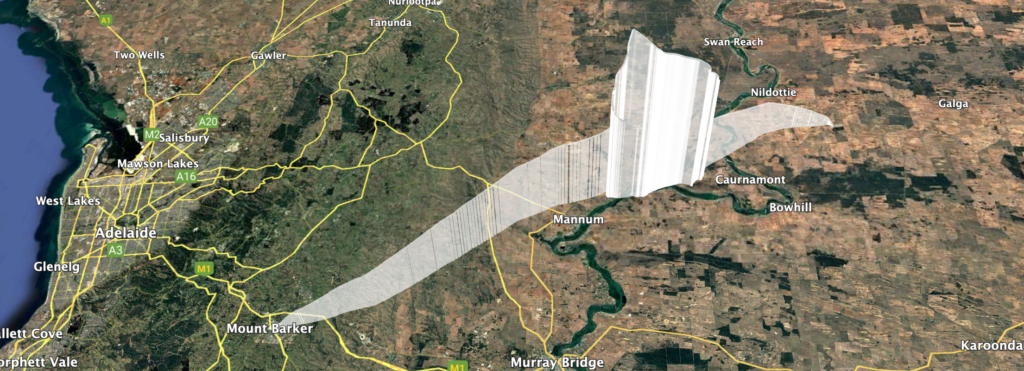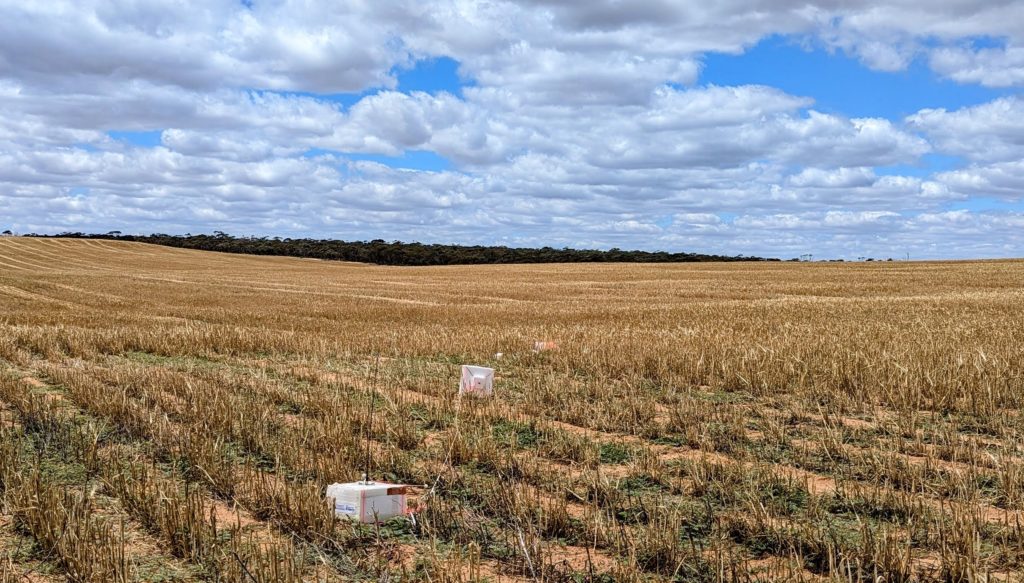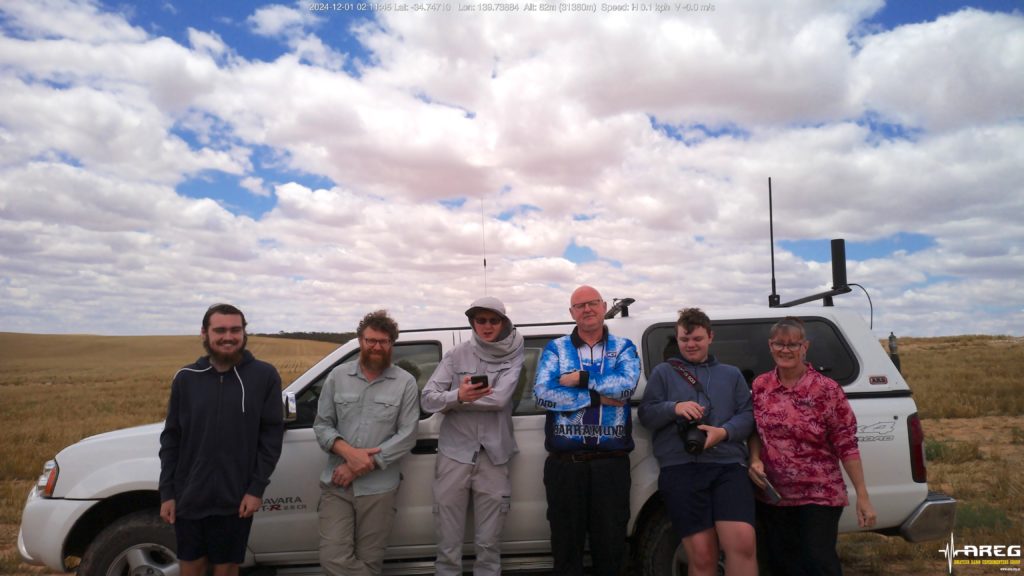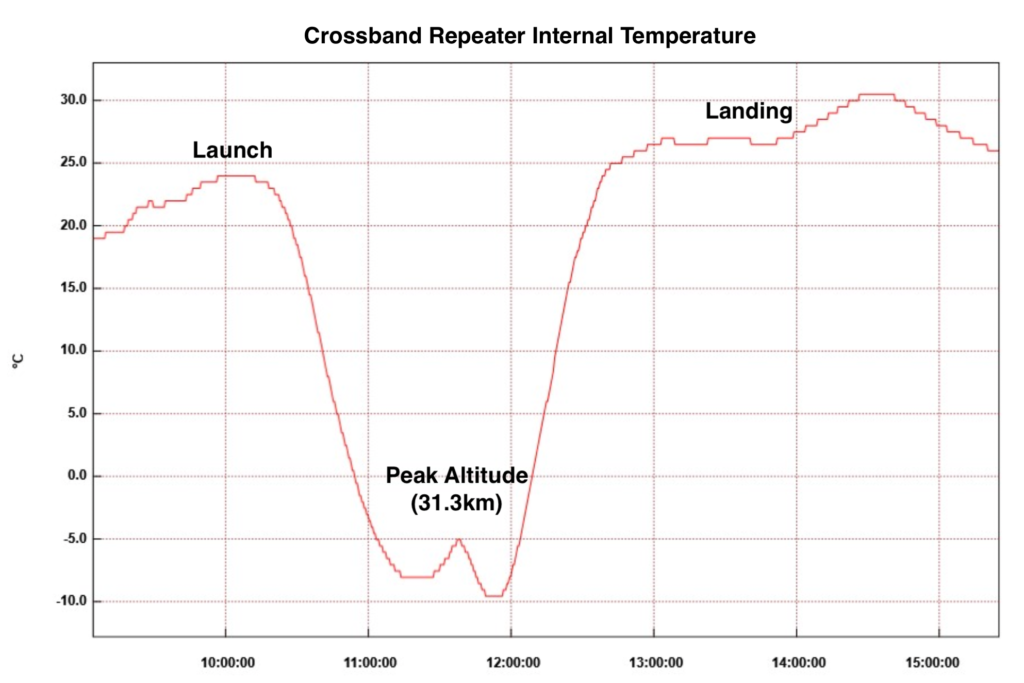Project Horus’s 63rd launch was run on the 1st of December 2024. This was the first flight of our new 2m/70cm cross-band repeater payload, and also flew an experimental imagery payload. The flight reached an altitude of 31359m before landing in a paddock to the east of Walker Flat. 68 different stations were heard on the cross-band repeater throughout the flight – a great result, and one that we hope to best on a future launch!
Launch, Chase & Recovery
Launch was a fairly relaxed affair, with a fairly small launch crew and fairly good weather at the launch site. A large flock of corellas did cause us a bit of concern, but thankfully they stayed clear of the balloon.
A time-lapse of preparations and launch is shown here:
After launch, the chase teams headed off towards the landing area, via a quick stop at Bowhill for coffee. This launch had Mark VK5QI and Will VK5AHV; Autumn VK5CLD; and Peter VK5APR chasing from the launch site.
The balloon reached a peak altitude of 31359 m above Younghusband, before bursting and descending for a landing to the east of Walker Flat.
As the chase teams from Mt Barker arrived near the landing area, they met up with Darin VK5IX and family (Glenys, Greg and Cameron), who were also out chasing. Everyone pulled over on the side of the road and were able to just catch a glimpse of the payloads landing on a paddock about 500m from the road.
The repeater was found to still be operational after landing, and the team were able to use this while coordinating the recovery. After obtaining permission from the landowners, the paddock was entered carefully (very sandy!) and the payloads recovered – with the obligatory Wenet payload team photo!
Cross-band Repeater Payload
The cross-band repeater performed flawlessly on its first outing, with contacts quickly filling up the log books of VK5ARG net control, run by Grant VK5GR. A big thanks to Grant for managing the repeater so the chase teams could focus on recovery!
The following stations were recorded in the log during the flight (displayed in alphabetical order):
VK3MTV, VK3TNU, VK5AAD, VK5AAF, VK5AAJ, VK5ABI, VK5AI, VK5ALG, VK5AVQ, VK5BB, VK5BBW, VK5BD, VK5CAT, VK5CJG, VK5CLD, VK5COL, VK5CV, VK5DBR, VK5FI, VK5FQ, VK5GA, VK5GAZ, VK5GF, VK5GH, VK5GX, VK5GY, VK5HMV, VK5HS, VK5IR, VK5IS, VK5IX, VK5JP, VK5JSA, VK5KA, VK5KFG, VK5KLD, VK5KVA, VK5KX, VK5LA, VK5LI, VK5LN, VK5MHZ, VK5MLO, VK5MN, VK5MRB, VK5MSD, VK5NE, VK5OI, VK5PET, VK5QI, VK5RK, VK5SC, VK5SFA, VK5SFA/R, VK5SPJ, VK5ST, VK5TRM, VK5TUX, VK5UW, VK5WA, VK5WV, VK5ZAR, VK5ZD, VK5ZKR, VK5ZLR, VK5ZM, VK5ZRK, VK5ZTS
Based on the log, we believe the furthest contacts were to Michael (VK5LN) in Pt Lincoln, and Tim (VK3TNU) in Horsham, Victoria – both around 325 km! Unfortunately the flight didn’t quite get high enough for reliable contacts in to Melbourne.
Theo VK5IR live-streamed the repeater contacts on Facebook throughout the flight – a recording of this is available on Youtube here:
One of the concerns with this payload was how hot (or cold!) it would get throughout the flight. Peter VK5KX provided a temperature logger which was installed into the payload box. This showed that the payload’s temperature stayed in a fairly reasonable range, dropping down to -10˚C during the ascent, and rising up to 30˚C after landing.
We’re still finalising our QSL card design for this flight – these will most likely get sent by the WIA QSL bureau to save on costs. If you’re not a members of the WIA and would like to be sent a card directly, please contact Mark at vk5qi@rfhead.net.
This repeater (after a few repairs) will certainly make an appearance on future launches, with the next aim to get it up to >35km to allow more contacts into VK3. We may also look into increasing the transmit power from 0.5W to 1.5W.
Primary Tracking Station – VK5KX & VK5ZM
Up on Angas Valley Road, overlooking the Murray-lands area, Peter VK5KX and Matt VK5ZM had set up a portable ‘super station’, which provided reliable reception of the imagery and telemetry throughout the flight. Peter’s station used a Wimo 70cm X-Quad beam on a Az/El rotator, while Matt’s used a vinnant.sk 70cm turnstile. Peter was able to receive almost all of the imagery transmitted during the flight! Grant VK5GR was also setup nearby running net control for the repeater – thanks guys!
Thanks to Glenys Roberts for the photos from the receiver site.
Wenet Imagery Payload
This flight aimed to evaluate the PiCam v3 camera (previously tried on Horus 59) in auto-focus mode, with lots of software improvements and additions from the previous flights. Many more telemetry datapoints were transmitted in realtime during the flight, including RPi CPU and Radio temperature, and even the live lens position as the PiCam v3 attempted to autofocus.
Sadly we still had autofocus issues resulting in many blurry images, however the additional telemetry transmitted to the ground during this flight provided a lot of data to help improve performance on future launches. The full telemetry from this payload is available on a Grafana dashboard here.
A big thanks to the stations that set up to receive Wenet imagery and telemetry on this flight:
VK3TNUpi, VK5ALG, VK5CLD-9, VK5DSP, VK5KX-9, VK5QI-9, VK5ST, VK5ZM
We’d also like to thank the Raspberry Pi foundation developers for providing lots of advice on how to best optimise the autofocusing system, and we plan to continue working with them to push the limits on what a PiCam v3 can do!
Horus Binary Telemetry Payloads
Our trusty Horus Binary telemetry payloads worked fine throughout the flight, providing our primary flight tracking ability. Thanks to the following stations that helped track these payloads:
HORUS-V2 Payload: BARC-RRR, VK3APJ, VK3GP, VK3TNU, VK5AAF, VK5AI, VK5ALG, VK5ALG-9, VK5APR, VK5ARG, VK5BD, VK5CLD-9, VK5COL, VK5DSP, VK5GA, VK5GY, VK5HS, VK5IS, VK5IX, VK5KX-9, VK5KX-i5, VK5LA, VK5LN, VK5MSD, VK5NEX, VK5NTM, VK5OI, VK5PE, VK5QI-9, VK5RK, VK5SPJ, VK5ST-4, VK5TRM, VK5TUX, VK5ZM, VK5ZQV, vk5cv, vk5mhz
VK5ARG Payload: BARC-RRR, VK3TNU, VK5ALG, VK5ALG-9, VK5APR, VK5ARG, VK5BD, VK5CLD-9, VK5HS, VK5KX-9, VK5NTM, VK5QI-9, VK5ST-4, VK5TRM, VK5TUX, VK5ZM
Full statistics on how many packets each station received, and their reported Signal-to-Noise Ratio (SNR), are available on the flight dashboard here.
TheThingsNetwork Payload
Liam’s TheThingsNetwork payload flew again, with a total of 98 gateways receiving telemetry. The furthest receiver was located near Finley, NSW, at a distance of 557km.
A map showing the receiver locations is below, with more detail available on the flight dashboard.
Conclusion
Thanks to everyone that participated in this flight, through helping at the launch, tracking, chasing, or calling into the repeater!
We hope to do a re-fly of this launch in the new year (towards the end of summer), aiming to get the repeater payload up high enough to give coverage further into VK2 and VK3 – stay tuned!























